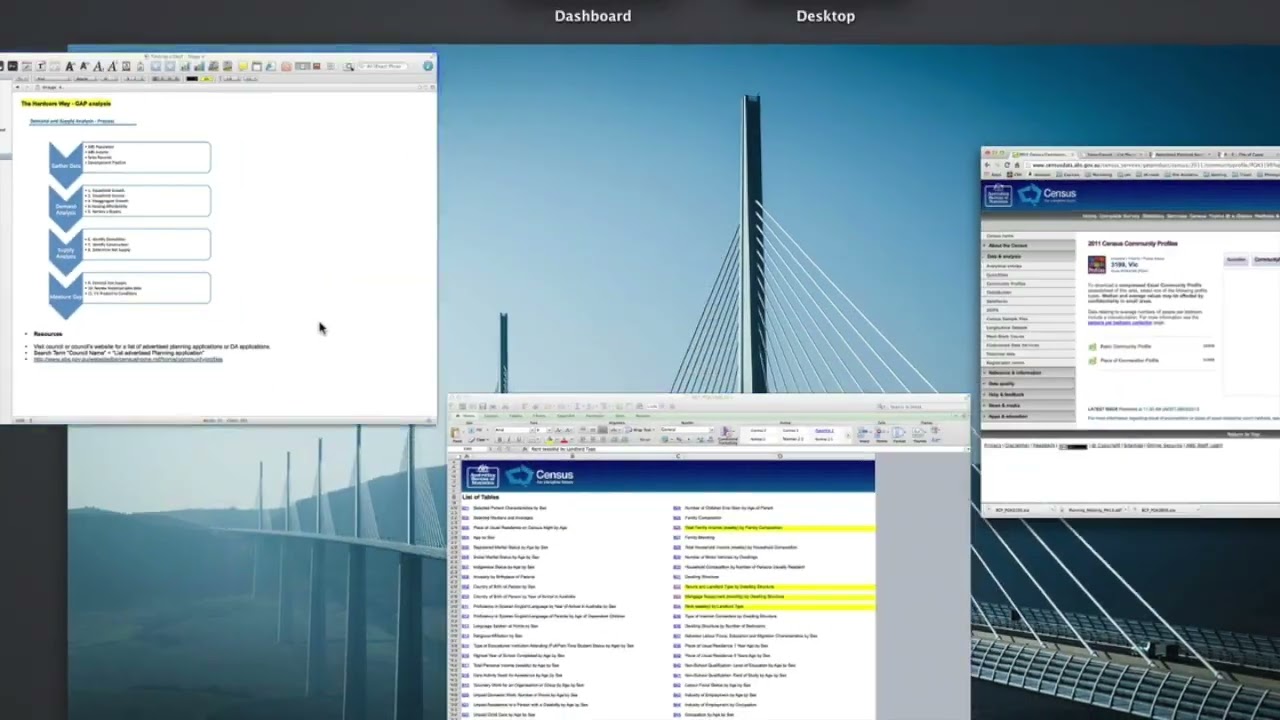Validating signals - Stage 4
Here, we will focus on the most exhaustive stage of validating signals, which involves determining the supply or demand in an area. Despite its complexity, the video shows insights into a streamlined approach for conducting such analyses without being overly entangled in statistical data.
Data Gathering
Emphasis on collecting data from various sources to understand population, income levels, sales records, and development pipelines within a suburb.
Use of ABS and Councils
Directions on utilising the ABS for demographic information and visiting council websites or offices to get a list of all developments in the pipeline.
Analysis Example
A walkthrough on how to analyse community profiles for insights into family income, mortgage repayments, and rent, aiding in identifying target markets based on affordability.
Historical Sales Data
Historical sales data spanning at least three to four years is important for assessing the demand for different types of dwellings in the area.
Planning Applications
Reviewing council planning applications to understand ongoing developments and their implications on your project.
Demand and Supply Calculation
A comprehensive approach to calculating demand and supply, identifying household growth, affordability, demolition, and construction and analysing historical sales data to determine the market demand for specific types of units.
Insights based on numbers:
- The analysis suggests the necessity of digging into detailed data such as family weekly income composition and mortgage repayments to pinpoint the suburb’s affordability.
- Emphasises historical sales data and planning applications to deduce the supply and demand dynamics effectively.
Frequently Asked Questions
What role do planning applications play in assessing the potential impact of new developments on existing projects?
Planning applications play a crucial role in assessing the potential impact of new developments on existing projects by providing insight into future constructions in the area. They help developers understand upcoming projects’ scope, type, and location, enabling them to anticipate competition, market saturation, and demographic changes.
This information is essential for making strategic decisions, such as modifying project designs, adjusting pricing strategies, or identifying market gaps. Reviewing planning applications allows developers to manage risks and opportunities related to new developments proactively, ensuring their projects remain competitive and aligned with market demands.
What type of data is important to collect during this stage?
In this stage, it’s crucial to collect a variety of data to get a comprehensive understanding of the market. Important data types include population figures, income levels, sales records, and information on development projects within a suburb.
How can the ABS and council resources be utilized in this process?
The Australian Bureau of Statistics (ABS) can be used to gather demographic information, providing insights into the community’s composition. Council websites or offices can be visited to obtain a list of all developments in the pipeline, offering a glimpse into future supply changes.
What does analyzing community profiles involve?
Analyzing community profiles involves examining data such as family income, mortgage repayments, and rent levels. This analysis helps in identifying target markets based on affordability, giving clues about the demographic’s ability to purchase or rent in the area.
Why is historical sales data important?
Historical sales data, spanning at least three to four years, is crucial for understanding the demand for different types of dwellings in the area. It reveals trends and preferences in the housing market, aiding in demand assessment.
What is the purpose of reviewing council planning applications?
Reviewing council planning applications is essential to understand ongoing and future developments, which can significantly impact the supply side of the market. It provides insights into what types of dwellings are being built and their potential effects on the area.
How is demand and supply calculated?
Demand and supply calculation involves a comprehensive approach that considers factors such as household growth, affordability, demolition, and construction. By analyzing historical sales data, one can determine the market demand for specific types of units.
What insights can be drawn from the detailed data analysis?
The detailed data analysis highlights the importance of understanding the suburb’s affordability through metrics like family weekly income composition and mortgage repayments. It also emphasizes the role of historical sales data and planning applications in effectively deducing the supply and demand dynamics.
Test Your Knowledge
Multiple-Choice Questions on Validating Signals
1. What is the primary objective of Stage 4 in validating signals?
A. To streamline statistical analysis methods
B. To determine the supply or demand in a specific area
C. To finalize project designs based on current market trends
D. To calculate the overall profitability of real estate investments
2. Which of the following is NOT a key type of data to be collected in Stage 4?
A. Population growth predictions
B. Income levels and sales records
C. Favorite colors of the local population
D. Development pipelines within a suburb
3. How can the ABS be utilized in this process?
A. By providing financial assistance for developments
B. For gathering demographic information
C. For legal advice on property development
D. By predicting future real estate trends
4. Why is analyzing community profiles important?
A. To create more effective marketing campaigns
B. To understand public opinion on local politics
C. To identify target markets based on affordability
D. To design the exterior of buildings more attractively
5. What does historical sales data help to assess?
A. The effectiveness of past marketing strategies
B. Demand for different types of dwellings in the area
C. The architectural styles preferred in the past
D. The success rates of real estate agencies
6. What is the purpose of reviewing council planning applications?
A. To find potential legal issues with new developments
B. To understand ongoing developments and their market implications
C. To estimate the future population growth in the area
D. To assess the environmental impact of new constructions
7. What factors are considered in the demand and supply calculation?
A. Color preferences and design trends
B. Household growth, affordability, demolition, and construction
C. Political climate and potential zoning changes
D. Interest rates and stock market performance
8. Which insight is NOT correctly associated with detailed data analysis?
A. Understanding the suburb’s affordability through income and repayments
B. Using color preferences to predict future design trends
C. Deduction of supply and demand dynamics with historical data
D. Emphasis on planning applications for supply and demand insights
Answers
- B. To determine the supply or demand in a specific area
- C. Favorite colors of the local population
- B. For gathering demographic information
- C. To identify target markets based on affordability
- B. Demand for different types of dwellings in the area
- B. To understand ongoing developments and their market implications
- B. Household growth, affordability, demolition, and construction
- B. Using color preferences to predict future design trends
Assignment
Understanding Market Dynamics in Real Estate Development
Objective:
This assignment aims to provide students with a practical understanding of validating signals in the context of real estate development, specifically focusing on determining the supply and demand in a specific area. Through a series of tasks, students will engage with real-world data collection, analysis, and interpretation to understand market dynamics thoroughly.
Tasks:
1. Data Collection:
- To Do: Choose a suburb or a small geographical area in your city for analysis.
- Research Question: What sources can you use to collect data on population, income levels, sales records, and development pipelines in your chosen area? List at least three sources.
2. Utilizing ABS and Council Resources:
- To Do: Access the Australian Bureau of Statistics (ABS) to gather demographic information about your chosen area. Additionally, visit your local council’s website or office to get a list of all developments in the pipeline.
- Research Question: What specific demographic information from ABS and what development pipeline data from the council will be most useful for your analysis? Explain your choices.
3. Analyzing Community Profiles:
- To Do: Using the data collected, analyze the community profile focusing on family income, mortgage repayments, and rent levels.
- Research Question: How can this information help identify target markets based on affordability in your area? Provide a detailed analysis.
4. Historical Sales Data:
- To Do: Collect historical sales data for the past three to four years for different types of dwellings in your area.
- Research Question: What trends can you identify from this historical sales data? How does it help assess demand for different types of dwellings?
5. Planning Applications Review:
- To Do: Review planning applications submitted to the local council to understand ongoing developments.
- Research Question: What types of developments are ongoing in your area, and how might they impact the current and future supply?
6. Demand and Supply Calculation:
- To Do: Calculate the demand and supply in your area by considering household growth, affordability, demolition, and construction.
- Research Question: Based on your calculations, is there a surplus or deficit in the supply of dwellings in your target market? Explain your findings.
7. Insights Based on Numbers:
- To Do: Dig into detailed data such as family weekly income composition and mortgage repayments to analyze the suburb’s affordability.
- Research Question: What insights can you draw about the affordability and market demand for specific types of units in your area?
Deliverables:
- A detailed report comprising the findings from each task. The report should include data sources, methodologies, analyses, interpretations, and conclusions.
- Visual aids (charts, graphs, tables) to support your analysis.
- Recommendations for real estate developers looking to invest in or develop properties in your chosen area, based on your findings.
Submission Guidelines
- The report should be submitted in a PDF format.
- Ensure your analysis is clear, logical, and supported by data.
- Submit your assignment via the mail or comment.



